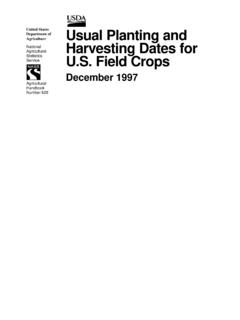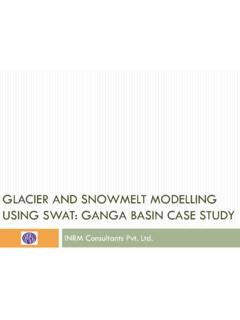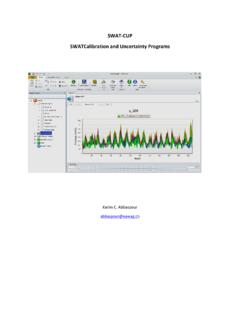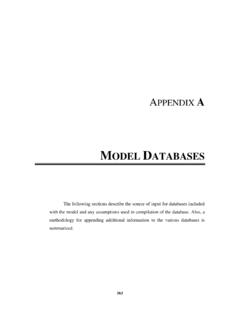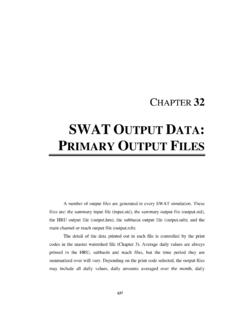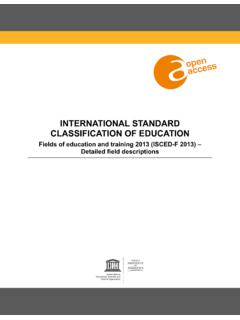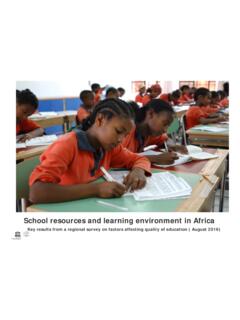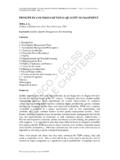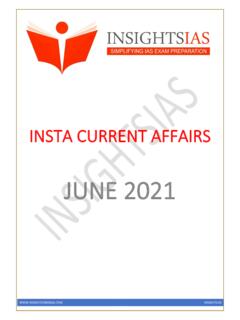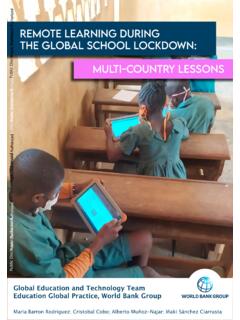Transcription of SWAT: MODEL USE CALIBRATION AND VALIDATION
1 Transactions of the ASABE Vol. 55(4): 1491-1508 2012 American Society of Agricultural and Biological Engineers ISSN 2151-0032 1491 SWAT: MODEL USE, CALIBRATION , AND VALIDATION J. G. Arnold, D. N. Moriasi, P. W. Gassman, K. C. Abbaspour, M. J. White, R. Srinivasan, C. Santhi, R. D. Harmel, A. van Griensven, M. W. Van Liew, N. Kannan, M. K. Jha ABSTRACT. SWAT (Soil and Water Assessment Tool) is a comprehensive, semi-distributed river basin MODEL that requires a large number of input parameters, which complicates MODEL parameterization and CALIBRATION . Several CALIBRATION tech-niques have been developed for SWAT, including manual CALIBRATION procedures and automated procedures using the shuf-fled complex evolution method and other common methods. In addition, SWAT-CUP was recently developed and provides a decision-making framework that incorporates a semi-automated approach (SUFI2) using both manual and automated CALIBRATION and incorporating sensitivity and uncertainty analysis.
2 In SWAT-CUP, users can manually adjust parameters and ranges iteratively between autocalibration runs. Parameter sensitivity analysis helps focus the CALIBRATION and uncer-tainty analysis and is used to provide statistics for goodness-of-fit. The user interaction or manual component of the SWAT-CUP CALIBRATION forces the user to obtain a better understanding of the overall hydrologic processes ( , baseflow ratios, ET, sediment sources and sinks, crop yields, and nutrient balances) and of parameter sensitivity. It is important for future CALIBRATION developments to spatially account for hydrologic processes; improve MODEL run time efficiency; include the impact of uncertainty in the conceptual MODEL , MODEL parameters, and measured variables used in CALIBRATION ; and as-sist users in checking for MODEL errors.
3 When calibrating a physically based MODEL like SWAT, it is important to remember that all MODEL input parameters must be kept within a realistic uncertainty range and that no automatic procedure can substitute for actual physical knowledge of the watershed. Keywords. Autocalibration, Hydrologic MODEL , SWAT, VALIDATION . he SWAT (Soil and Water Assessment Tool) mod-el is a continuous-time, semi-distributed, process-based river basin MODEL . It was developed to evaluate the effects of alternative management decisions on water resources and nonpoint-source pollution in large river basins. The first version of SWAT was devel-oped in the early 1990s and released as version Engel et al. (1993) reported the first application of SWAT in the peer-reviewed literature; Srinivasan and Arnold (1994) and Arnold et al.
4 (1998) later published the first peer-reviewed description of a geographic information system (GIS) inter-face for SWAT and overview describing the key compo-nents of SWAT, respectively. Arnold and Forher (2005) de-scribed the expanding global use of SWAT as well as several subsequent releases of the MODEL : versions , , , and 2000. Gassman et al. (2007) provided fur-ther description of SWAT, including SWAT version 2005, and also presented an in-depth overview of over 250 SWAT-related applications that were performed worldwide. Krysanova and Arnold (2008), Douglas-Mankin et al. (2010), and Tuppad et al. (2011) provide further updates on SWAT application and development trends, and the latter two articles provide further description of SWAT version 2009, the latest release of the MODEL .
5 The development of SWAT is a continuation of USDA Agricultural Research Service (ARS) modeling experience that spans a period of over 30 years (Gassman et al., 2007; Williams et al., 2008). The current SWAT MODEL includes key components contributed from USDA-ARS models as well as from other models (fig. 1). Core pesticide transport, hydrology, and crop growth models that have been incorpo-rated into SWAT can be traced to earlier USDA-ARS field- Submitted for review in November 2011 as manuscript numberSW 9517; approved for publication by the Soil & Water Division ofASABE in May 2012. The authors are Jeffrey G. Arnold, ASABE Fellow, Agricultural En-gineer, USDA-ARS Grassland, Soil and Water Research Laboratory, Tem-ple, Texas; Daniel N.
6 Moriasi, ASABE Member, Research Hydrologist,USDA-ARS Great Plains Agroclimate and Natural Resources ResearchUnit, El Reno, Oklahoma; Philip W. Gassman, ASABE Member, Asso-ciate Scientist, Center for Agricultural and Rural Development, Iowa StateUniversity, Ames, Iowa; Karim C. Abbaspour, Senior Scientist, Eawag:Swiss Federal Institute for Aquatic Science and Technology, D bendorf,Switzerland; Michael J. White, ASABE Member, Agricultural Engineer, USDA-ARS Grassland, Soil and Water Research Laboratory, Temple,Texas; Raghavan Srinivasan, ASABE Member, Director, Spatial Sci-ences Laboratory, Texas A&M University, College Station, Texas; Chin-nasamy Santhi, Associate Research Scientist, Texas Research and Exten-sion Center, Temple, Texas; Daren Harmel, ASABE Member, Research Leader, USDA-ARS Grassland, Soil and Water Research Laboratory,Te mple, Texas; Ann van Griensven, Associate Professor, UNESCO-IHE Institute for Water Education, Delft, The Netherlands; Michael W.
7 VanLiew, Hydrologic Computer Simulation Modeler, Department of Biologi-cal Systems Engineering, University of Nebraska, Lincoln, Nebraska; Na-rayanan Kannan, ASABE Member, Assistant Research Scientist, TexasResearch and Extension Center, Temple, Texas; and Manoj K. Jha,ASABE Member, Assistant Professor, College of Engineering, NorthCarolina A&T, Greensboro, North Carolina. Corresponding author: Jef-frey G. Arnold, USDA-ARS Grassland, Soil and Water Research Labora-tory, 808 East Blackland Road, Temple, TX 76502; phone: 254-770-6502; e-mail: T 1492 TRANSACTIONS OF THE ASABE scale models (fig.)
8 1): the Groundwater Loading Effects of Agricultural Management Systems (GLEAMS) MODEL (Leonard et al., 1987), the Chemicals, Runoff, and Erosion from Agricultural Management Systems (CREAMS) MODEL (Knisel, 1980), and the Environmental Policy Integrated Climate MODEL (Williams et al., 2008; Wang et al., 2011). These components were first grafted into the Simulator for Water Resources in Rural Basins (SWRRB) MODEL (fig. 1; Arnold and Williams, 1987), along with other key compo-nents including a weather generator, sediment routing rou-tine, and groundwater submodel (Arnold and Allen, 1999). The initial version of SWAT was then created by interfac-ing SWRRB with the routing structure in the Routing Out-puts to Outlet (ROTO) MODEL (fig.
9 1; Arnold et al., 1995b). Expanded routing and pollutant transport capabilities have since been incorporated into the MODEL (fig. 1), including reservoir, pond, wetland, point source, and septic tank ef-fects as well as enhanced sediment routing routines (Arnold et al., 2010b) and in-stream kinetic routines from the QUAL2E MODEL (Brown and Barnwell, 1987). Additional modifications that have been incorporated into SWAT (fig. 1) include an improved carbon cycling routine based on the CFARM MODEL (Kemanian, 2011), alternative daily and subdaily hydrology routines including the Green-Ampt infiltration method (Green and Ampt, 1911), temporal ac-counting of management practice and land use changes and enhanced subsurface tile drainage, filter strips, grassed wa-terways, irrigation, and other improved representations of conservation and management practices (fig.
10 1; Arnold et al., 2010b). The temporal accounting routine allows users to introduce the adoption of different selected management practices or account for changes in land use part way through a SWAT simulation run, such as the hydrologic and pollutant impacts simulated by Chiang et al. (2010) in re-sponse to temporal changes in pasture use for a 32 km2 wa-tershed in northwest Arkansas. The current SWAT2009 code incorporates all of the components shown in figure 1 as well as other routines, and also features several pre- and post-processing software tools, including the widely used ArcGIS SWAT (ArcSWAT) GIS interface (Olivera et al., 2006). Extensive SWAT2009 documentation can also be accessed at the SWAT website ( ), including theoretical docu-mentation describing all equations, a user s manual describ-ing MODEL inputs and outputs, ArcSWAT and Map Window interface manuals, and a developer s manual.
